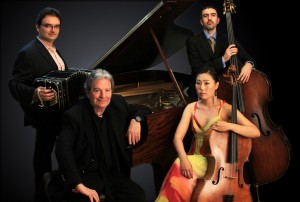Tango nuevo in Old La Jolla

Classical Tango Quartet (photo courtesy of the Artist)
It took the tango 100 years to make its way from the slums and brothels of Buenos Aires to the refined environs of La Jolla. But Saturday’s (Aug. 18) SummerFest concert featuring Pablo Ziegler and his Classical Tango Quartet proved this Argentine music could rub shoulders with Schubert and Brahms and hold its head high.
As pianist, composer and arranger, Ziegler benevolently dominated the program, which featured a generous collection of music by that icon of tango nuevo Astor Piazzolla—mainly in arrangements by Ziegler—and his own tango compositions. Ziegler’s assured presence at the piano was the thread that tied together this varied, invigorating evening.
From the rippling glissandos and jostling, angular motifs of Piazzolla’s program-opening “Michelangelo 70” for two pianos, Ziegler and his SummerFest keyboard colleague John Novacek evoked that urban energy and psychic congestion that is a hallmark of this sophisticated development of tango music from the last third of the 20th century. In another Piazzolla two-piano offering, “Buenos Aires Hora Cero,” Novacek indulged in a few extended instrumental techniques (e.g. plucking low strings with his left hand) while Ziegler churned a dark, ominous passacaglia bass. And in “Revirado,” the two pianists reveled in the composer’s animated, tongue-in-cheek depiction of the typical male Argentine tango dancer’s bravado.
Ziegler accompanied three SummerFest soloists in the more clasically oriented tango compositions. Who could resist Cho-Liang Lin’s heart-melting violin cantilena in Piazzolla’s “Oblivion” or cellist Carter Brey in a set of three other Piazzolla works? Perhaps because “Oblivion” is such a tender, almost ethereal, piece, Ziegler found just the right dynamic level to balance Lin.
But the assertive pianist quite overpowered Brey in the showy figurations of “Libertango” and “Escualo,” a shame because Brey brought such finesse to the complex cello role in these pieces. Clarinetist Burt Hara soloed in a pair of Ziegler’s own works, including a soulful, elegaic take on “Milonga del Adios,” a work written shortly after Piazzolla’s death in 1992 and dedicated to his memory.
As the regular pianist in Piazzolla’s New Tango Quintet, aka the second Quintet (1978-1988), Ziegler is considered by most Latin American music aficionados to be the custodian of the tango nuevo legacy. On the second half of Saturday’s SummerFest concert Ziegler and his Classical Tango Quartet gave the fullest picture of this jazz-influenced mode of tango.
With Héctor del Curto on bandoneón—Piazzolla’s instrument—the Classical Tango Quartet has not only the essential instrumental color of tango nuevo, but a player with the virtuoso technique to apply to those complex parts that Piazzolla wrote for himself. The bandoneón is a kind of accordion, with buttons on both sides (as opposed to the traditional accordion’s keyboard for the right hand) and a sonority that is less polished and more earthy that that of the accordion.
In the Classical Tango Quartet, bassist Pedro Giraudo functions like a stand-up bass player in a jazz ensemble: he does not follow a chart, but improvises an active bass line—more plucked than bowed—that follows the harmonic progressions within each piece. Like bassist Eric Revis who worked with Branford Marsalis in SummerFest’s opening week, Giraudo displayed a continuously inventive line that proved as captivating as any sleek melody he was supporting.
Cellist Jisoo Ok completed Ziegler’s quartet, covering most of the mid-range textures with polished, supple lines, but leaving most of the melodic effusions to either the bandoneón or the right hand of the piano. We heard several of Ziegler’s own compositions, including his “Once Again Milonga” and “Just Around the Corner Tango.”
The ensemble closed with Piazzolla’s “Fuga Mysterioso,” a tribute to the compsitional studies the composer took with Nadia Boulanger some time after his own tango style had taken shape. But this fugue and variations set displayed a creative imagination that could craft a bold, extended fugue subject and develop it with the winning panache equal to that of any “serious” composer.
SummerFest 2012 continues through Friday, August 24, at the Museum of Contemporary Art San Diego’s Sherwood Auditorium, 700 Prospect St., La Jolla. See www.ljms.org for program details.

Ken Herman, a classically trained pianist and organist, has covered music for the San Diego Union, the Los Angeles Times’ San Diego Edition, and for sandiego.com. He has won numerous awards, including first place for Live Performance and Opera Reviews in the 2017, the 2018, and the 2019 Excellence in Journalism Awards competition held by the San Diego Press Club. A Chicago native, he came to San Diego to pursue a graduate degree and stayed.Read more…
